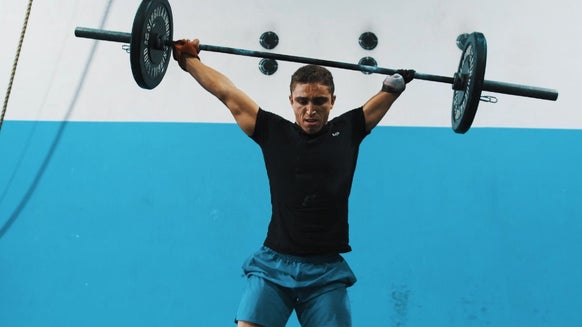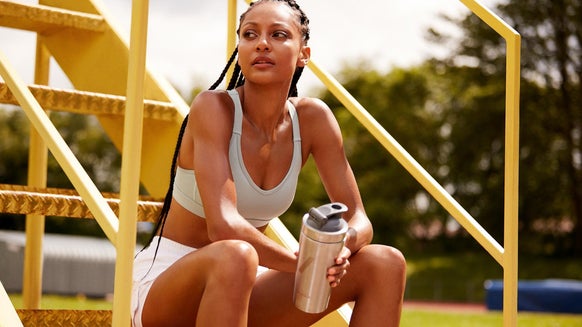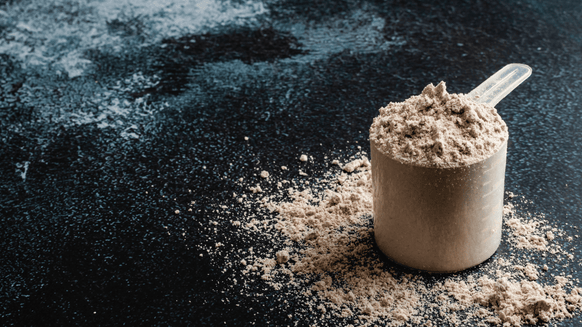Back Attack | 6 Must-Do Back Exercises For Mass

Developing a wide, thick back can tremendously improve the look of your physique. The famous v-taper creates the illusion of a small waist and great size. To achieve it you will need to attack your back with a dose of exercises targeting a number of muscles.
Endless sets of pull-ups will only get you so far, that is if you can lift yourself of the floor to being with… Most seasoned trainees could also use a tweak or two and re-evaluate their exercise form, making sure that they get the most out of their time in the gym. Read on and find out how to put your back to it!
Back Muscles Anatomy
The back is a large and complex muscle group. The illustration below shows some of the back muscles, which can be easily targeted with exercises reviewed in the next section of this article.
As you can see, the fibres of back muscles run at different angles – this justifies the usage of varied grips, handles and machines when training. After all, in pursuit of a monster back you don’t want to leave any muscle fibre unturned.

In depth evaluation of each muscle is beyond the scope of this article - to simplify, the development of latissimus dorsi and teres major is responsible for creating the width of the back (aka the desirable v-taper). Whereas, the underneath running rhomboids and erector spinae give back its thickness.
A properly designed training programme should target all of these muscles avoiding any disproportions.
Conventionally, the back muscles can also be divided into:
? Upper Back: Rhomboids, trapezius, teres and upper part of the latissimus dorsi,
? Lower Back: Lower latissimus dorsi and lower regions of erector spinae.
When strongly developed, erector spinae can be seen “through” the thoracolumbar fascia - connective tissue which cannot be trained itself.
The step-by-step exercise guide below will ensure that you get the most out of your training, implementing some tweaks to work on both back width and thickness at the same time!
1) Deadlifts
Deadlifts are one of the “biggest bang for your buck” exercises, engaging tremendous amount of muscles! – Virtually all of the back muscles, abdominals, thighs and buttocks.
The movement is considered as the best back thickness builder, providing great erector spinae stimulation.
Notably, the deadlift is essentially a safe lifting technique which will accompany you when lifting the barbell off the floor in other exercises, as well as when lifting items of day to day use. Lifting shopping bags with style.

? Stand facing the barbell with your feet shoulder width apart. Contract your abdominals, push your chest up keeping your back straight and bend your knees until you can reach the bar.
? Grab the bar with a pronated grip (thumbs facing each other), make sure that your grip is slightly wider than shoulder width – use the rings on the bar as a point of reference, to ensure that your grip is even.
? Make sure that your grip is tight, your abdominals and lower back contracted, chest lifted up and back straight. Fix your eyes on a point in front of you, inhale and hold your breath.
a) Start lifting the bar of the floor by straightening your legs and keeping the bar close to your body - Once the bar reaches your knee levels straighten your legs while extending your back.
b) Stop the movement once you’re stood perfectly upright. Do not hyperextend your back – your shoulders and hips should be in a straight line.
c) Exhale and hold this position for 2 seconds while bringing your scapulae together for extra upper back stimulation.
d) In a controlled manner, return the barbell to the floor by flexing your back and bending your thighs. While doing so maintain correct posture – keeping head up, back straight, chest pushed up and abdominals contracted.
SETS, REPS: Do plenty of warm-up sets with lighter weight, 3 to 4 sets of 10 repetitions. Once warmed-up perform heavy 3 to 4 sets of 6-8 reps.
2) Barbell Rows
Barbell row is yet another compound and brutal exercises for back development. It allows using the heaviest weight out of all rowing exercises - this of course is of great benefit when building mass. The movement stimulates trapezius, rhomboids, teres major and latissimus dorsi.
Freedom to change the angle between the torso and the floor during the exercise allows to easily throw in some extra cheated reps to boost the intensity.

? Keep a slight bent in your knees and lean forward, forming a 45° between your torso and the floor. Smaller angle (standing more upright) will engage more trapezius muscles and greater angle will hit your lower back – you may need to experiment with optimal positioning for your body type.
? Make sure that your back is straight, chest pushed up and head kept straight, looking in front of you.
a) Grab the bar with a pronated grip (thumbs facing each other), placing your hands slightly wider than shoulder width.
b) Pull the barbell along your thighs up to your navel (belly-button). Your biceps and forearms should only serve a purpose of holding on the weight – you should not contract them.
c) Pull the barbell with your elbows (not your biceps.)
d) At the top bring your shoulder blades together and hold the contraction for 2 seconds before lower the weight back down to decelerate.
SETS, REPS: Perform 3-4 heavy sets of 6-8 repetitions.
3) Dumbbell Rows
Dumbbell rows help with developing wide and thick back; engaging latissimus dorsi, rhomboids, teres major and trapezius. The exercise can also be considered as core stability movement, as it requires holding the torso rigid, without tilting (spine rotation) or bending (spine flexion) your back.
This exercise is a great rows variation, allowing for unilateral work; where each arm works independently of each other. Your arm is the strongest in the neutral grip used in this exercise, allowing to operate with heavy weight while going easy on your shoulders.

? Place a dumbbell on the left side of a flat bench. The bench will be used for a support.
? Place your right knee on the lower part of the bench, bend in the waist and place your right hand on the upper part of the bench. Your torso should be close to parallel to the floor, back kept straight and abdominals tight.
? Lower yourself down to grab the dumbbell using a neutral grip (thumbs facing up).
? Keep a slight bent in the elbow and lift yourself up to the previous position, without rounding your back.
a) Pull be dumbbell up, focusing on driving your elbow as far back as you can - The dumbbell should travel in a straight line, close to your body and brushing against your hip at the top of the movement. Your torso should stay rigid throughout the movement.
b) Hold the dumbbell at the top for a second, focusing on contracting your lats, rhomboids and traps. Your scapula should be retracted (drawn back in) as far as possible.
c) Slowly lower the dumbbell down, allowing your scapula to stretch. Go as low as you can without tilting your back to the side.
d) Hold the stretch for a second. Without having a break, repeat the exercise using the right arm (dumbbell on the right, left knee and arm on the bench) – that’s one set.
SETS, REPS: Perform 3-4 sets of 10-12 reps.
5) Cable Lat Pull-downs
Pulldowns are an excellent width-builder, targeting mainly the latissimus dorsi and teres major. However, with few tweaks described in the step by step guide, it will also target rhomboids and lower trapezius building extra back thickness.
Cable pull-downs are a great alternative to traditional chin-ups, which require strength proportional to bodyweight. Most often, this requirement won’t be met by beginners and advanced physique athletes who carry a lot of weight.

? Attach a wide bar to the pulley and adjust the knee pad of the machine.
? The knee pad allows you to lock your thighs in a position; preventing the weight of the stacks from lifting you up.
? Grab the bar with a pronated grip (thumbs facing each other) - hands placed slightly wider than shoulder width.
? Holding the bar, sit down in the seat and lock your thighs in place using knee pads.
a) Keep your shoulders in line with your hips, duck your head and allow the weight to stretch your back - you should focus on relaxing your lats and allowing them to stretch - hold the stretch for a second.
b) Bring your head back up and pull the bar down to your upper chest while slightly extending your back to allow for greater range of motion. Focus on pulling your elbows as far bas as possible, it doesn't necessarily mean touching your chest with the bar.
c) Once your elbow are maximally pulled back focus on brining your shoulder blades together, squeeze your back and hold the contraction for a second.
d) Slowly lower the weight, reverting back to keeping your shoulder in line with your hips.
SETS, REPS: You can use this exercise to warm-up and isolate your lats by pyramiding the weight up. Perform 4 sets for 15, 12, 10 and 8 reps; increasing weight on every set.
5) Barbell Shrugs
Upper trapezius muscle can be fairly easy to develop without any direct work. The muscle gets a fair share of stimulation from a vast amount of compound back exercises.
However, if you feel like your neck appears to be too slender… or having a neck simply annoys you, then barbell shrugs are the answer. Many lifters chose to exercise this muscle directly, using shrugs.

? Stand facing the barbell with your feet shoulder width apart. Contract your abdominals, push your chest up keeping your back straight and bend your knees until you can reach the bar.
? Grab the bar with a pronated grip (thumbs facing each other), make sure that your grip is slightly wider than shoulder width.
? Make sure that your grip is tight, your abdominals and lower back contracted, chest lifted up and back straight. Fix your eyes on a point in front of you
? Start lifting the bar of the floor by straightening your legs and keeping the bar close to your body - Once the bar reaches your knee levels straighten your legs while extending your back.
a) While keeping your arms fairly rigid, lift your shoulders (shrug) as high as possible. Imagine that you’re trying to bury your head into your shoulders, without moving your neck.
b) Hold the contraction for 3 seconds, squeezing your back as hard as you can.
c) Lower the barbell back down and let the weight stretch your traps.
d) Repeat from step 2 for a desired number of repetitions.
SETS & REPS: 3-4 sets of 10-15 repetitions, holding the contraction for at least 3 seconds
Bent Arms Dumbbell Pull Overs
This exercise is a great way to finish off your back session, allowing you to stretch your lats using heavy load. This could lead to more growth – the scientific evidence of loaded stretch effect on muscle hypertrophy is somewhat lacking.
However, anecdotally many physique athletes believe that it allows the muscles to “expand”. Truth or not, flexibility developed by this exercise will prevent injuries and increase your mobility.

? Place a dumbbell upright, on top of a bench, just off the edge.
? Lie on your back across the bench, so that only your shoulder blades touch its surface - Importantly, your neck should be off the bench to prevent cervical spine injuries.
? Place your feet firmly on the ground and drop your hips down.
? Grab the dumbbell in both hands, pressing your palms against the inner-side of the weight plates - to ensure a secure grip you can tangle your thumbs around the handle and wrap your fingers around the edge of the dumbbell.
a) Place the dumbbell above your head and bend your elbows (keeping arms too straight will engage more chest than back).
b) Keeping your arms rigid, slowly lower the dumbbell behind your head as fat as comfortable.
c) Hold the stretch for a second and raise the dumbbell back until it’s above the tip of your head. Raising the dumbbell to just before your forehead will put more emphasis on your back.
d) Squeeze your chest and keep the contraction for a second.
SETS & REPS: Perform 2-3 sets of 12 repetitions, focusing on the stretching.
Sample Back Training Programme
| Exercise | Sets and reps |
| Cable Pull Downs | 3 x 15, 12, 10 and 8 reps |
| Barbell Rows: | 3 x 6-8 (each till failure) |
| Dumbbell Rows: | 3 x 10-12 |
| Barbell Shrugs | 3 x 15 (3 sec hold at top) |
| Dumbbell Pull-Overs | 2 x 12 |
| Deadlifts | 3x10 Warm up, 3x6-8 (sets till failure) |
A Take Home Message
Back muscle is a large and complex muscle group requiring a range of well thought and even better executed exercises. The sample training programme is a good starting point to grow some serious slabs of muscle hanging off your back.
Give it a go and let us know about your gains!








